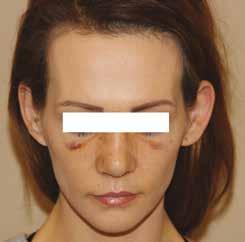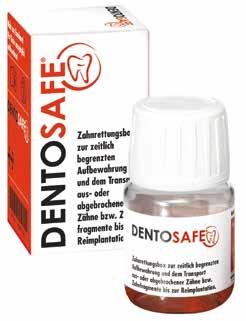
6 minute read
Polodoc: Facial Injuries
by Edit
Dr.med. Andreas Krüger is a Swiss board orthopaedic and trauma surgeon in Zurich, who specialises in knee and shoulder surgery. Andi is a second generation of tournament doctors for equine sports, known as Polodoc since 2013
Facial Injuries
Advertisement
Teeth are beauty & air is life
Mike Tyson is not known for his intellectual capacity but has said something very true, “Everyone has a plan till they get punched in the face”.
When managing the risk of sustaining an injury to the nose, teeth or eyes (the second most common polo injury), not to mention skull and brain injuries; effective protective gear would certainly come in handy. Other high impact sports do have protective gear already, but it has yet to fully arrive in polo.
Injury Characteristics
Massive forces from fast flying hard plastic balls, helicoptering novices or hard-hitting sticks swung by professionals can leave vast destruction in the integrity of the bony and soft tissues of the face. The primary care, such as salvaging knocked out teeth, could be more sophisticated. Mistakes in first response can have a major impact on the final result. Secondly, the rehabilitation is long and the healing can be insufficient leaving marks on performance and in appearance.
Injury to the Teeth
Nearly everybody has sustained a little injury to the teeth in their life. Especially contact sports pose a high risk for the oral system. Starting with a relatively harmless injury the damage might not show right away. If teeth are chipped or knocked loose, they’ve probably absorbed most of the force and it will be obvious that you need to see a dentist. But even if your teeth are intact, the nerves, jawbone or underlying dental tissue may have been injured because they absorbed some of the force. Therefore you should visit a dental office after every injury, no mater how small an accident to get the actual situation clinically and radiologically checked. This can also be an important topic when it comes to insurance issues. The white outside layer of the tooth is called enamel. It is made of a crystalline, lifeless matrix of calcium and phosphorus that is the hardest substance in the body. Inside the enamel is the dentin. The dentin is a vital structure containing millions of nervecanals which are connected to the nervechamber, called the pulp.Teeth are set into the jawbone with prong-like roots and held there by tiny bands of fibrous tissue called the periodontal ligaments.
If chipping of the enamel and dentin happens try to find the part, and save it. In some situations it can be replaced and avoid further treatment. But even if the chip is lost, dentists today can fix a tooth with white esthetic composit, a resin-like matieral. Usually that can be repaired in one trip to the dentist. A bigger chip may require more work-up with a ceramic restoration that fits over the damaged tooth. If the chip exposed the pulp — even just a little bit of it — chances are that bacterias will infect it. The trauma itself may also cause damage. In either case, you’ll have to wait at least a few weeks before the dentist knows for sure whether the pulp is viable. You’ll need a root canal procedure, which involves removing the pulp and replacing it with a rubberlike filling.
In some situations the damaged tooth can’t be saved. If the root is cracked in the deep parts, the tooth needs to be removed. It will then be replaced by an implant.
Knocked Out of Position
Sometimes every minute counts and a visit to the dentist should be organised as soon as possible. If the tooth isn’t badly dislocated, the dentist will gently move it back into the proper position and splint it for a view weeks. Doing so soon after the trauma may help preserve the pulp and the periodontium. A dental splint looks like a small set of braces. Wires are attached to the injured tooth and those on either side of it, holding it in place while it heals and reattaches to the jaw. When a tooth is knocked out, it tears the periodontal ligament tissue, some of which will be still on the tooth. Knocked out teeth should be put back in the socket as soon as possible. This should only be done by a professional. In order to bridge the time to the dentist, the tooth should be put in a box containing own saliva or better in a safebox. Scraping or scrubbing will harm the tissue and reduce the chances of the tooth reattaching to the jaw.
Injury to the Jawbone
Only the nose is broken more frequently. A broken jaw is the 10th most common fractured bone in the human body. Fractures are generally the result of massive direct force to the jawbone. Men are about three times more likely than women to sustain a broken jaw. About 42% of jawbone fractures occur only on one side of the jaw. A large percentage of patients with jawbone fractures had associated injuries to head, neck, face, eyes, and nose.
The jawbone, or mandible is the largest and main bone of the lower part of the face.
Fractures may cause a damage to bigger blood vessels or nerve tracts and should be treated immediately. To fully stabilise and reconstruct multiple facail injuries a consultation with a specialist for oral and plastic surgery is recommended.
Injury to the Nose
The human nose is the most protruding part of the face. Apart from for breathing it is also the principal organ in the olfactory system. The shape of the nose is determined by the nasal bones and the nasal cartilages, including the nasal septum which separates the nostrils and divides the nasal cavity into two. When a deformity happens the main function of the nose – breathing – can be impaired. In cases of massive trauma even the olfaction (sense of smell) can be reduced. With a change of the nose form or size, the character of the voice can change. There are many plastic surgery procedures on the nose, known as rhinoplasty available



Rhinoplasty corrects various structural defects or changes the shape of the nose after trauma
Case Study: Juancito Bollini
Professional Polo Player, Model and USPA Brand Ambassador
He was hit with a stick after a massive swing. He sustained a fracture of the frontal bone of his face and lost the upper front teeth on the field with massive bone destruction.
Multiple surgeries with reconstruction of the jaw bone with bone graft and implants of the front teeth resulted in a full recovery after two and a half years with no relevant impairment aesthetically or functionally. Bollini recommends mouth guards, especially for beginners.
to correct various structural defects or to change the shape of the nose after trauma. Badly positioned cartilages and lack of proper support can affect the function of the external nasal valve. This can cause breathing problems particularly during deep inhalation. The surgical procedure to correct these breathing problems due to disorders in the nasal structures is called rhinoplasty. With a septoplasty a nasal septum deviation can be surgically corrected in a mini invasion fashion. Minor fractures to your nose may heal on their own.
For more information on Polodoc contact Andreas Krüger at drmedkrueger@gmail.com or www.polodoc.ch
Knocked out teeth should be placed in cold milk, saltwater solution or a product such as Dentosafe and taken to the dentist
PD Dr.med. Thomas Biesgen, plastics specialist
Expert Opinion
First Response: Combination of Plastics & Dentistry Knocked out tooth & extensive face injuries
If possible put the tooth in a safebox. When there is no safebox at hand, put the tooth in cold milk or a saltwater solution until you can see a dentist, which should be as soon as possible. If there’s no milk or saltwater solution handy, saliva is better than plain water. Never put the tooth in a napkin or tissue. That dries it out, which damages the periodontal ligament tissue.
For more extensive injuries of the face an initial cleaning and sterile / clean dressing can be helpful to stop bleeding.
Dr. Gregory Lüscher, dentistry specialist











